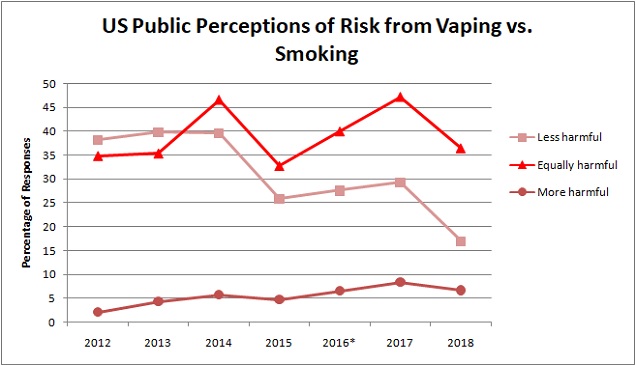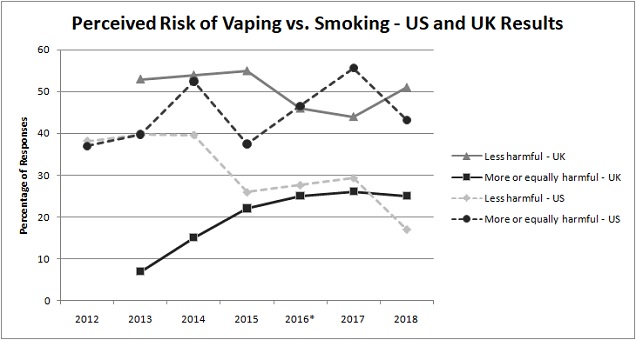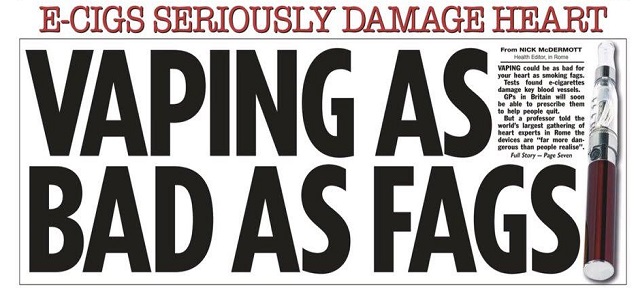
Vaping is substantially safer than smoking. Whether it’s 95 percent safer, 99 percent safer or just “a lot” safer isn’t important; what matters is that if you’re a smoker and you switch to vaping, you have a massively reduced chance of dying as a result of your nicotine addiction.
For most people reading this blog, this won’t be a surprise. You’ll have heard about Public Health England’s review of the evidence, you’ll have seen the Royal College of Physician’s report and you might have read some other academic reviews of the evidence and noticed that the conclusion is always the same. There is no legitimate debate about whether vaping is safer than smoking anymore; it just is.
But for the general population, it’s not as easy an issue to get to the bottom of. With conflicting news reports coming out each week, dedicated pressure groups explicitly or implicitly pushing a “just as bad as smoking” narrative and a whole lot of panic about what vaping is doing to our youth, it’s not the easiest issue to get a handle on as a casual onlooker.
We’ve spoke about the problems that come from this before, namely that shocking numbers of people don’t know that vaping is safer than smoking, including current smokers. But now there are two new studies – one from the US and one from the UK – that offer a bit of a deeper dive into this problem.
I’d like to say that there’s good news and bad news, but the truth is that there is bad news and more bad news. However, if you squint at some of the bad news from the UK in the right way, it reveals a slight glimmer of hope.
OK, I know it doesn’t sound promising but that’s the best we’ve got. So let’s dive in.
Why Harm Perceptions Matter

Before looking at the new research in detail, it’s important to underline why this issue matters. You might argue that the information is out there for anybody open-minded enough to find it – and it certainly is – so what does it matter what Joe next door thinks?
The problem is that public perceptions give us an idea of the thing that really matters: the perceptions of smokers who’ve yet to try vaping. The last time we covered this issue, the data from the UK revealed that the most common reason smokers give for not trying vaping is that they are concerned that e-cigarettes aren’t safe enough, closely followed by concerns about “substituting one addiction for another” and not thinking they’re useful for quitting.
The key point is that negative opinions on the safety of effectiveness of vaping reduce the number of smokers willing to try them. If we inhabited the imaginary world some tobacco control advocates are apparently living in, we would see this as good news because smokers will just try to quit using another, better-studied approach. But we have to live in reality, and in reality this doesn’t happen. In reality, they will probably keep smoking, and if they never quit, a large proportion of them will die as a result.
How Dangerous Do Americans Think Vaping is?

The latest results from the Health Information National Trends Survey (HINTS) don’t paint a positive picture. In the 2018 survey, a group of 3,495 respondents were prompted with, “Compared to smoking cigarettes, would you say that electronic cigarettes are…” and had to choose from “much less harmful” (the correct answer), “less harmful,” “just as harmful,” “more harmful,” “much more harmful” and “I don’t know.” Based on the respondents’ answers, the researchers estimated the proportion of the US population holding these views.
The results show that only 2.6 percent – roughly one in 38 – Americans correctly answered that vaping is much less harmful than smoking. Another 14.4 percent – about one in seven – said they were less harmful, making 17 percent in total who think that vaping is safer than smoking.
A whopping 36.5 percent said that vaping was just as harmful, 3.8 percent said they were more harmful, and a depressing 2.9 percent had swallowed so much nonsense that they actually believed vaping was much more harmful than smoking. And it’s also worth noting that 37.6 percent of respondents didn’t know whether they were safer.
Back in 2012, in contrast, about 38 percent of the population thought vaping was less harmful than smoking. The situation is getting worse, and this graph – which groups all “less harmful” and “more harmful” results together, as well as omitting “never heard of” or “don’t know” – makes it abundantly clear.

*Note that there is no data from the survey for 2016, so I interpolated between the 2015 and 2017 results.
The number thinking vaping is equally harmful has generally increased, the number thinking they’re less harmful has reduced by more than half and the number saying they’re more harmful has steadily risen.
At this point it shouldn’t come as much of a surprise that the same survey shows that in 2017, only 13.4 percent of respondents said that smokeless tobacco is safer than smoking, which it definitely is.
To really drive the point home, in 2017, almost 27 percent of respondents said that low nicotine cigarettes were safer than ordinary cigarettes. This is a full 10 percentage points higher than the number saying vaping is safer. In other words, about one in four Americans think low nicotine cigarettes are safer than traditional cigarettes, while only one in six think vaping is safer.

This, in a word, is a travesty.
How Dangerous Do Brits Think Vaping Is?
The situation in the UK is pretty different, on the face of it. Public health authorities tend to be much more positive about vaping and generally say things that are actually true rather than focusing on a few choice misleading soundbites.
The new study (funded by Cancer Research UK) does confirm that British people are more likely to have an accurate understanding of the relative risks of vaping and smoking. However, the results still aren’t exactly encouraging. Out of the 1,720 participants (at the time of the survey – September 2017), 57.3 percent correctly responded that vaping was safer than smoking. On the other side, 3.3 percent said vaping was more harmful than smoking, and 21.8 percent said they were equally harmful, with the remaining 17.6 percent saying they didn’t know.
Earlier data from the survey, covering 2012 to 2014, shows that perceptions have again been moving in the wrong direction.

In 2012, 66.6 percent said vaping was safer, but in 2014 it had dropped to 60.4 percent, and the latest round of data shows it’s still moving in the wrong direction. Additionally, the number saying vaping was just as bad as smoking rose from 9 to 16.9 percent from 2012 to 2014, and the number saying more harmful increased from 1.5 to 2.1 percent. Again, these measures are moving in the wrong direction.
The study also asked what people thought the main harms of vaping were, and the most common answer (from 48 percent of respondents) was that there hasn’t been enough research to know all of the possible harms. The next most common answers were that the chemicals in the liquid might be harmful (41.6 percent) and that “you don’t know exactly what you’re getting” because of a lack of regulation and quality control (37.8 percent).
There is other data on this same topic from ASH UK (under “Use of e-cigarettes among adults in Great Britain, 2018”), and this generally shows the same thing. It isn’t quite as positive – with just 51 percent saying some variation of “less harmful” in 2018, but only 25 percent saying more or equally harmful. I’ve compiled a similar graph of this data from 2013 to 2018 to show the trends, which are still moving in the wrong direction (although there is some suggestion of improvements last year) but undoubtedly more positive than in the US.

However, it’s worth noting that the smokers who haven’t tried vaping or who’ve tried vaping and stopped are more likely to say they’re just as harmful as smoking or worse.
Is the Problem a Lack of Knowledge of Vaping, or Just a Lack of Knowledge?
There aren’t many positives to be pulled out of this set of data, but some additional negative points do help to put the results into context a little.
In the recent study from the UK (not the ASH one shown in the graph above), the researchers also asked about nicotine in general and nicotine replacement therapies. The results for these questions show that this irrational fear of nicotine in the form of vaping isn’t exactly unique.
When asked what proportion of the health risks of smoking are down to nicotine, only 11.2 percent correctly responded “none or very small,” with another 24.5 percent saying “some but well under half.” On the other side, 11.5 percent said “nearly all the risk” comes from nicotine, and 16.3 percent said “much more than half the risk.” Finally, 21.8 percent said about half of the risk of smoking is from nicotine.
For NRT, this same fear of nicotine showed itself again. While 63.4 percent said that patches and gums are safer than smoking, 1.9 percent said they were more harmful and 15.2 percent said they were equally harmful. While only 57.3 percent said vaping was safer, this is pretty close to the proportion saying NRT is safer.
The researchers note that:
Accurate nicotine knowledge was associated with greater odds of responding that: EC are less harmful than tobacco cigarettes; NRT are less harmful than tobacco cigarettes; health harms would reduce a great deal if a smoker stopped smoking and used EC instead.
In short, if people knew the facts about nicotine, they were more likely to have an accurate picture of the risks of vaping or NRT.
Data from the US HINTS survey show a similar level of misunderstanding around nicotine. Notably, 51.3 percent of respondents thought that nicotine is the substance that causes most of the cancer from smoking. This is – of course – completely wrong. Only 25.2 percent disagreed.
Another striking result from the US survey is that a massive 87.7 percent of respondents had not looked for information on e-cigarettes from any source. The vast majority clearly gain information passively, whether from a water-cooler conversation or likely-misleading headlines floating around on social media.
The conclusion from all of this is that risk perceptions around vaping are a problem, but far from the only problem. On the contrary, the data paints a pretty clear picture: people don’t understand the risks of nicotine-containing products in general. The authors of the UK study hit on this point too, suggesting a potential way forwards:
Correcting misperceptions concerning nicotine may therefore help with understanding about the relative risks of different nicotine delivery products.
This whole picture is as depressing as ever, but this is the closest thing there is to a positive take-away. In the UK in particular, the view of the risks of vaping is approaching the view of the risks from NRT, and there is a chance that more focus on the facts about nicotine, rather than vaping specifically, could help both of these move in the right direction.
Why the Difference Between the US and UK?
As the post should have made clear, there is a pretty substantial difference in the understanding of the risks and benefits of vaping between the US and the UK. Here are the percentages of people who say vaping is safer than smoking vs. those who say it’s as bad or even worse for both countries over time:

The difference is pretty striking. For the 2018 data, there is a gap of about 25 percentage points between the two groups in both countries, except in the UK “less harmful” is a much more common response, whereas in the US “more or equally harmful” is the dominant view.
The divide here might seem confusing, until you go through the process of looking up the facts on vaping as if you were in each country. It’s almost always best to go to official sources when you’re looking up health-related issues, so let’s do that.
The UK NHS page on e-cigarettes opens with:
An estimated 2.9 million adults in Great Britain currently use e-cigarettes and of these, 1.5 million people have completely stopped smoking cigarettes. They carry a fraction of the risk of cigarettes and can be particularly effective when combined with extra quitting support.
And under “How safe are e-cigarettes?” it reads:
In the UK e-cigarettes are tightly regulated for safety and quality. They aren't completely risk free, but they carry a small fraction of the risk of cigarettes. E-cigarettes don't produce tar or carbon monoxide, two of the most harmful elements in tobacco smoke. The liquid and vapour contain some potentially harmful chemicals also found in cigarette smoke but at much lower levels.
Public Health England's 2015 independent evidence review found that, based on the available evidence, vaping is around 95% less harmful than smoking. The Royal College of Physicians came to a similar conclusion in its 2016 report ‘Nicotine without smoke: tobacco harm reduction'.
This is clear, accurate and honest. The only way you could come away from this page with the wrong impression is if you manage to convince yourself that “Big Vape” has somehow infiltrated the NHS, the Royal College of Physicians and Public Health England.
Now, to the CDC’s About Electronic Cigarettes page. It opens with the much vaguer and more restrictive statement of the key fact:
E-cigarettes have the potential to benefit adult smokers who are not pregnant if used as a complete substitute for regular cigarettes and other smoked tobacco products.
Farther down the page – after you scroll past sections telling you about “cancer-causing chemicals” in vapor and how “scientists are still learning about their long-term health effects” – the “Are e-cigarettes less harmful than regular cigarettes?” section reads:
Yes—but that doesn’t mean e-cigarettes are safe. E-cigarette aerosol generally contains fewer toxic chemicals than the deadly mix of 7,000 chemicals in smoke from regular cigarettes. However, e-cigarette aerosol is not harmless. It can contain harmful and potentially harmful substances, including nicotine, heavy metals like lead, volatile organic compounds, and cancer-causing agents.
The information is essentially the same as the NHS page, but the framing of the information is completely different. The initial “yes” is the most positive and least misleading part of the whole thing. While the NHS basically says “yes, they’re much safer; not perfect, but vastly better than smoking,” the CDC says “yes, better than the deadly mix of chemicals in cigarette smoke but they’re still not safe. They have scary chemicals in.”
Even small details like saying “generally contains fewer toxic chemicals” (implying that they sometimes contain more) rather than just “contains fewer toxic chemicals” (aka the truth) creates a very different impression. The CDC emphasizes danger and doubt, even when directly responding to a question with an unambiguous answer, while the NHS simply provides the unambiguous answer, and even goes a step further by dispelling the common misconceptions surrounding chemicals in vapor.
The CDC may feel justified because the truth is technically in there (mainly in one word, but still), but this just simply isn’t good enough. The proof is in the data: people in the US are more likely to misunderstand the relative risks of vaping than people in the UK.
But the UK Situation Still Isn’t Great, So Who is Responsible?

Last time we covered research like this, the conclusion was that while public health groups that play up the dangers of vaping take some of the blame, most of it falls on the media.
The fact that the situation is worse in the US clearly shows the impact of official sources being honest about vaping. People do generally trust official sources, and so what they say really matters. If you’re in public health, you can make a difference.
But this can’t change the conclusion that the main portion of the blame falls onto the media. Even in the much more positive environment in the UK, perceptions of risk have been moving in the wrong direction and the number correctly identifying vaping as safer than smoking is still too low. But if you don’t actively search for information on vaping (which it seems most people don’t), all you’re left with are what the media says and what you pick up from word-of-mouth, which ultimately probably comes from the media again.
So journalists, vying for clicks in an increasingly-competitive environment, might feel justified in latching onto a study and playing up the scariest angle for clicks, but the truth is that they are discouraging people from making a positive decision for their own health. In the US, this compounds with misleading information from official sources to create what can only be described as a deplorable and downright embarrassing misunderstanding among the public.
Professor Peter Hajek, commenting on the new UK study for Science Media Centre, hits the nail on the head:
This is an important study with serious implications for public health. Vaping poses only a small fraction of risks of smoking, but over the past few years, we have seen a barrage of misinformation about e-cigarettes that has been persuading smokers that vaping is dangerous and that they should stick to smoking. Some ‘fake news’ are of little importance, but this study shows that fake news on dangers of e-cigarettes did penetrate the public consciousness and are likely to be harming public health. Health organisations and responsible media now face an urgent task to correct this misinformation.

